Unsolicited via e-mail from Pete Myers
I just spent 4 days in the field in a graduate course in bird photography taught by Artie Morris at Fort DeSoto. After almost 50 years of experience pointing cameras at birds from the Arctic to Tierra del Fuego, New Zealand and beyond, I thought I was good enough. But what I learned from Artie in just four days has taken me to a whole new level. As he aptly puts it, “birds as art,” not simply bird photography. One of those 4 days was the most satisfying I’d ever experienced, anywhere. The IPT left me euphoric about what I’d learned, and frighteningly committed to recreating my portfolio with the techniques and insights he taught me.
Unsolicited via e-mail from IPT veteran Eugen Dolan
Arthur, Thank you very much for your overwhelming infectious enthusiasm that helped get me up on some mornings. Also, your ability to express yourself- and explain in great detail why you like or may not like an image – was very helpful in allowing me to better analyze my images. Eugen
Via e-mail from Jim Miller
I can’t stop thinking about how much fun the DeSoto IPT was, and how much I learned. There were so many things that suddenly made perfect sense after I had been confused for so long. Thank you very much for the wonderful trip, and for being a great teacher. As I worked through the raw files last week, I realized what a fantastic lens the 600 IS is. Thanks for the rental! Maybe someday I will be able to afford one. Some images for critique are attached. Thank you again, Artie. It was really wonderful to be with you and learn from you.
Via e-mail from Lee Sommie
I want to thank you for making the Fort DeSoto IPT; it was a fun and educational experience for me. I truly did not want the adventure to end. I now look through the viewfinder with an artist’s mindset. And the real bonus was making new friends with fellow students. Thank you for sharing your knowledge and enthusiasm for wildlife photography. I had a great time with you and look forward to more adventures on future IPTs.
Via e-mail from Muhammad Arif
I had a great time at Fort De Soto. Thank you for all the instruction, for your help and pointers; my photography has already improved tremendously, and I’ve never made such good bird photos before. I wish I could’ve joined you on Monday and Tuesday morning as well, but work got in the way. It was also nice meeting the folks on the IPT. Thanks again for everything and I hope to join you at a future IPT sometime again.
|
|
|
Fort DeSoto in spring is rife with tame birds, many in full breeding plumage. Click on the composite to enjoy a larger version. Clockwise from upper left around to center: Laughing Gull landing on head of Brown Pelican, Laughing Gull in flight, Reddish Egret sunrise silhouette, Great Blue Heron with needlefish, Yellow-crowned Night Heron with ghost crab, Roseate Spoonbill, Sanderling in breeding plumage, and white morph Reddish Egret in glorious breeding plumage. |
The 2023 Spring Fort DeSoto Instructional Photo Tours (IPTs)
Spring Fort DeSoto IPT #1: Tuesday 28 March through the morning session on 31 March 2023. 3 1/2 Days: $1899.00 includes three working brunches. Limit six photographers.
Spring Fort DeSoto IPT #2: Tuesday 11 April through the morning session on 14 April 2023. 3 1/2 Days: $1899.00 includes three working brunches. Limit six photographers/Openings: 5.
Spring Fort DeSoto IPT #3: Tuesday 9 May through the morning session on 12 May 2023. 3 1/2 Days: $1899.00 includes three working brunches. Limit six photographers/Openings: 4.
Fort DeSoto, located just south of St. Petersburg, FL, is a mecca for terns and gulls, wading birds, and shorebirds in spring. Many of the birds will be in full breeding plumage. Simply put, DeSoto is the new Ding Darling. Migrant shorebirds are in abundance, and many are exceedingly tame. We should have great chances on Royal and Sandwich Terns and both white- and dark-morph Reddish Egrets. Great Egret, Snowy Egret, Great Blue Heron, Tricolored Heron, and White Ibis are easy as well and we will almost surely come up with a tame Yellow-crowned Night-Heron or two along with some American Oystercatchers. We will enjoy lots of great flight photography, especially with the Brown Pelicans.
|
|
|
Again, Fort DeSoto in spring is rife with tame birds, most in breeding plumage. Click on the composite to enjoy a larger version. Clockwise from upper left around to center: Laughing Gull in flight, Yellow-crowned Night-Heron, Sandwich Terns copulating, Roseate Spoonbill, Great Egret with reflection, breeding plumage Short-billed Dowitcher, American Oystercatcher, Royal Tern, white morph Reddish Egret, and Snowy Egret in marsh. |
In Addition!
We should also get to photograph a variety of other shorebirds including Black-bellied, Semipalmated, Wilson’s, Snowy, and Piping Plovers, Willet, Dunlin, Short-billed Dowitcher, Marbled Godwit, and most especially, Red Knot, with many individuals in their handsome breeding plumages. In spring the T-shaped peninsula and the newly formed sandbar, Outback Key, are literally packed with avian treasures.
With just a bit of luck, we may get to photograph one of Florida’s most desirable species: Roseate Spoonbill. And we will surely get to do some Brown Pelican flight photography. With luck, they will have Laughing Gulls landing on their heads. And though not guaranteed, Wood Stork might well be expected. And we will be on the lookout for a migrant passerine fallout in the event of a thunderstorm or two.
|
|
|
Yes, Fort DeSoto in spring is rife with tame birds, most in breeding plumage. Click on the composite to enjoy a larger version. Clockwise from upper left around to center: breeding plumage Dunlin, dark morph Reddish Egret displaying, Laughing Gull vertical front-end portrait, Laughing Gull with prey item, landing on head of Brown Pelican, breeding plumage Royal Tern displaying, Royal Terns — pre-copulatory stance, Laughing Gulls copulating, Laughing Gull head portrait, breeding plumage Sandwich Tern with fish, and a rare treat, a breeding plumage White-rumped Sandpiper. |
What You Will Learn on a DeSoto IPT
- 1- The basics and fine points of digital exposure; how to get the right exposure every time after making a single test exposure (or before if you are using SONY gear).
- 2- How and why to work in Manual mode (even if you’re scared of it).
- 3- How to approach free and wild birds without disturbing them.
- 4- Lots about bird behavior and how to use that knowledge to help you create better images.
- 5- To age and identify many species of shorebirds including various sandpipers, plovers, dowitchers, and possibly yellowlegs.
- 6- To spot good situations and to choose the best perspective.
- 7- To see, evaluate, and understand the light.
- 8- To design pleasing images by mastering your camera’s AF system.
- 9- And perhaps most importantly, to evaluate wind and sky conditions and understand how they affect bird photography.
- 10- More than you could ever imagine.
|
|
|
You got it by now! Fort DeSoto in spring is rife with tame birds, most in breeding plumage. Click on the composite to enjoy a larger version. Clockwise from upper left around to center: Roseate Spoonbill, immature Brown Pelican in flight, the heron/egret hybrid, American Oystercatcher feeding, immature Royal Tern on railing, Great Egret morning silhouette, Black Skimmer in surf, and underside head portrait of Great Blue Heron. |
The Details
Morning sessions will run two and one-half to three hours; afternoon sessions about two. There is never a set schedule on an IPT — we adapt to the conditions. On cloudy mornings with the right wind, we may opt to photograph till noon and skip the afternoon session. That especially when the afternoon weather is looking iffy. We may opt to visit a great North Tampa rookery if conditions warrant that.
There will be a Photoshop/Image Review session before and after brunch (included) each of the three full days. That will be followed by Instructor Nap Time. Each of these IPTs will run with only a single registrant as I do not like disappointing anyone. The best airport is Tampa (TPA). Once you register, you will receive an e-mail with lodging information. Do know that it is always best if IPT folks stay in the same general area (rather than at home or at a friend’s place a good distance away).
Folks attending this IPT will be out in the field as early as possible and stay out late to take advantage of sunrise and sunset colors; this is pretty much a staple on almost all BIRDS AS ART Instructional Photo-Tours. Doing so will often present unique photographic opportunities, opportunities that will be missed by those who need their beauty rest and those who need to get home for a proper dinner. I really love it when I am leaving the beach at 9:30am on a sunny morning after a great session just as a carful or two of well-rested photographers are arriving … We will be getting wet.
Your $599 deposit is due now. Credit cards are OK for that. You can register by calling Jim or Jennifer during weekday business hours at 863-692-0906 with a credit card in hand. Once you leave a deposit, you will receive an e-mail with your balance statement and instructions for sending your balance check three months before the trip begins. If you wish to pay in full right off the bat, you can make your check out to BIRDS AS ART and send it via US mail here: BIRDS AS ART, PO BOX 7245, Indian Lake Estates, FL 33855. You will receive a confirmation e-mail with detailed instructions, and clothing and gear advice two months before the trip. Please shoot me an e-mail if you plan to register or if you have any questions.
IPT veterans and couples or friends signing up together may e-mail for discount information.
What’s Up?
I was up early and packing like a fiend on Friday. I had thought about heading down to the lake to check on the eaglets, but it was blessedly foggy. I did have time for a swim on what seemed like a summer afternoon. Jim dropped me off at the Courtyard Marriot Airport on his way home. With the rush-hour traffic, the “1 1/2-hour” trip took 2 1/2-hours. I had a nice dinner at Longhorn Grill. After getting to bed early, I woke at 3am, an hour before the alarm went off and caught the 4:30am shuttle.
Half the folks like Image #2 in yesterday’s post while the other hall liked #3. I’ll break the tie by stating that the third image, the orchestra conductor pose, was my favorite by a small margin over #2. Thanks to all who commented.
Today is Saturday 18 February 2023. I am on the way to the 2023 Homer IPTs. I have an early flight to Seattle and then continue on to Anchorage. I will pick up a big SUV at the airport and then overnight there with participants and friends Bob Eastman and Carolyn Johnson. We are planning on having dinner at the amazing So Thai and then driving down to Homer leaving early the next morning. Wish us luck (i.e., no blizzard).
If you have some cold weather gear and are free from about 23 or 24 February through March 3 or 4 and would like to join the second Homer IPT, please get in touch via e-mail ASAP as I am practically giving away the second IPT for free.
This blog post took about 90 minutes to prepare and makes three hundred twenty-six days in a row with a new educational post written just for you. Wherever you are and whatever you are doing, I hope that you too have a great day.
Please, please, pretty please remember to use m B&H or Bedford’s affiliate programs for all your new gear purchases. If you use B&H, please be sure to click on any B&H link in the blog to start your search. Or simply start with this link. There is always the option of e-mailing me for gear advice and for the correct links.
The plan is to continue to post every day until the streak reaches one year and one day and then posting every other day.
Please remember to use the B&H and Amazon links that are found on most blog pages and to use the BIRDSASART discount code at checkout when purchasing your new gear from Bedfords to get 3% back on your credit card and enjoy free second-day air FedEx. Please, also, consider joining a BAA IPT. You will be amazed at how much you will learn!
You can find some great photo accessories (and necessities, like surf booties!) on Amazon by clicking on the Stuff tab on the orange/yellow menu bar above. On a related note, it would be extremely helpful if blog-folks who, like me, spend too much money on Amazon, would get in the habit of clicking on the Amazon logo link on the right side of each blog post when they shop online. As you might expect, doing so will not cost you a single penny, but would be appreciated tremendously by yours truly. And doing so, works seamlessly with your Amazon Prime account.
Please remember that if an item — a Delkin flash card, or a tripod head — for example, that is available from B&H and/or Bedfords, is also available in the BAA Online Store, it would be great, and greatly appreciated, if you would opt to purchase from us. We will match any price. Please remember also to use my B&H affiliate links or to earn 3% cash back at Bedfords by using the BIRDSASART discount code at checkout for your major gear purchases. Doing either often earns you free guides and/or discounts. And always earns my great appreciation.
Air Travel Tips for Photographers
Be sure to weigh your checked bags before you leave home. I have been busted for being as little as 1/2-pound overweight. I checked in today with two Samsonite Spinners, one 49 1/2 pounds, the other 49 pounds. Th weight limit for some of the budget airlines like frontier are only 40 pounds/checked bag. It never hurts to check beforehand.
Remember that all Lithium batteries must go in your carry-ons. This include camera batteries and the batteries for most heated gloves, including and most especially the Motion Heat gloves that I recommend. If you pack your lithium batteries in your checked bag, you may wind up at your destination without them. But you will find a nice note in your luggage from the TSA.
In addition, small tool kits need to be in your checked bags, or you are at risk of having it confiscated by TSA.
|
|
|
This image was created on 25 March 2013 at Fort DeSoto Park with the tripod/Mongoose Action Head-mounted Canon EF 500mm f/4L IS II lens, the 1.4X EF tele-extender III, , and the EOS-1D X. ISO 4000: 1/2000 sec. at f/6.3 in Manual mode. Image #1: Mega-breeding plumage white morph Reddish Egret |
Breeding Plumage
The vast majority of folks photographing at Fort DeSoto go bonkers over the tame Reddish Egrets at Fort DeSoto year round. But, once you have seen them in mega-breeding plumage, you might — like me, not get quite as excited. They always dance like drunken sailors while plucking baitfish from the Gulf waters, but in spring, and both the dark and white morph birds get spectacular ultramarine-blue lores and bright pink and black bills. The killer gorgeous birds like the one above are usually found in March.
|
|
|
This image was created on 26 April 2022 on a Fort DeSoto IPT. While seated on wet sand behind my lowered, no-longer available (except from BAA) Induro GIT 304L tripod/Levered-Clamp FlexShooter Pro-mounted Sony FE 600mm f/4 GM OSS lens with the Sony FE 1.4x Teleconverter, and The One, the Sony Alpha 1 Mirrorless Digital Camera.. ISO 1000. The exposure was determined by Zebras with ISO on the rear wheel: 1/320 second at f/5.6 (wide open) in Manual mode. RawDigger showed that the raw file brightness was dead-solid perfect. AWB at 7:45:45am on sunny morning. Tracking: Spot S/AF-C with Bird-Eye/Face Detection performed perfectly. Click on the image to enjoy the high-res version. Image #2: Roseate Spoonbill in Hidden Lagoon in early morning light |
Hidden Lagoon
It is almost always worth checking out Hidden Lagoon. There are often spoonbills there in spring along with several other species including Little Blue Heron, Great and Snowy Egrets, White Ibis, Black Skimmers, and a variety of shorebirds including Willet, Red Knot, both yellowlegs, Least Sandpipers, and more. The spoonbills there can be ridiculously tame.
|
|
|
I created this image on 27 April on a Fort DeSoto IPT. Crouched down, I used the handheld Sony FE 200-600mm f/5.6-6.3 G OSS lens (at 529mm) and The One, the Sony Alpha 1 Mirrorless digital camera. ) The exposure was determined using Zebra technology with ISO on the Thumb Dial. ISO 800. 1/4000 second at f/6.3 (wide-open) in Manual Mode. AWB at 6:44:24pm on a sunny afternoon. Tracking: Zone with Bird Face/Eye Detection AF/C performed perfectly. Be sure to click on the image to enjoy a high-res version. Image #3: Laughing Gull flapping after bath
|
Laughing Gulls in Breeding Plumage
With their jet-black heads, bright wine-read bills, and white eye crescents, breeding plumage Laughing Gulls in spring are both drop-dead gorgeous and ignored by most bird photographers. As always, gulls make great practice subjects. You can master exposure, practice your compositional skills while getting to photograph lot of flight, action, and behavior. As I have been saying for decades, point your lens at a gull and you usually will not have to wait very long until it does something really nest.
DeSoto is my favorite place on the planet to photograph bathing gulls, terns, and shorebirds. On a DeSoto IPT, you will learn everything that there is to know about photographing bathing birds including the tell-tale signs that a bath is coming, how close to get, image design principles, the best AF methods to use with each system, choosing the best perspective, how to predict and photograph the after bath flaps, the repetitive nature of bathing locations, and more.
|
|
|
This image was created on 27 April 2022 on a Fort DeSoto IPT. While seated on damp sand behind my lowered, no-longer available (except from BAA) Induro GIT 304L tripod/Levered-Clamp FlexShooter Pro-mounted Sony FE 600mm f/4 GM OSS lens with the Sony FE 1.4x Teleconverter, and The One, the Sony Alpha 1 Mirrorless Digital Camera.. ISO 500. The exposure was determined by Zebras with ISO on the rear wheel: 1/1000 second at f/6.3 (stopped down 1/3-stop) in Manual mode. RawDigger showed that the raw file brightness was dead-solid perfect. AWB at 7:17:56 pm on sunny afternoon. Tracking: Spot S/AF-C with Bird-Eye/Face Detection performed perfectly. Click on the image to enjoy the high-res version. Image #4: Ruddy Turnstone in breeding plumage |
Breeding Plumage Shorebirds
On all three DeSoto Spring IPTs, we have excellent chances of photographing a variety of migrant shorebirds either in or molting into their bright, colorful breeding plumages. Ruddy Turnstones are very much on the drab side in basic plumage. In spring, the males — like the bird in the photo above — are more brightly colored than their mates and feature bright red-orange and black harlequin patterned upper parts and orange legs. This bird was photographed at my favorite afternoon spot.
Your Call?
Which of today’s four featured images is the strongest? All are invited to leave a comment and let us know why they made their choice. Though I love all four, I do have a clear favorite and will share that here with you tomorrow.
Typos
With all blog posts, feel free to e-mail or to leave a comment regarding any typos or errors.

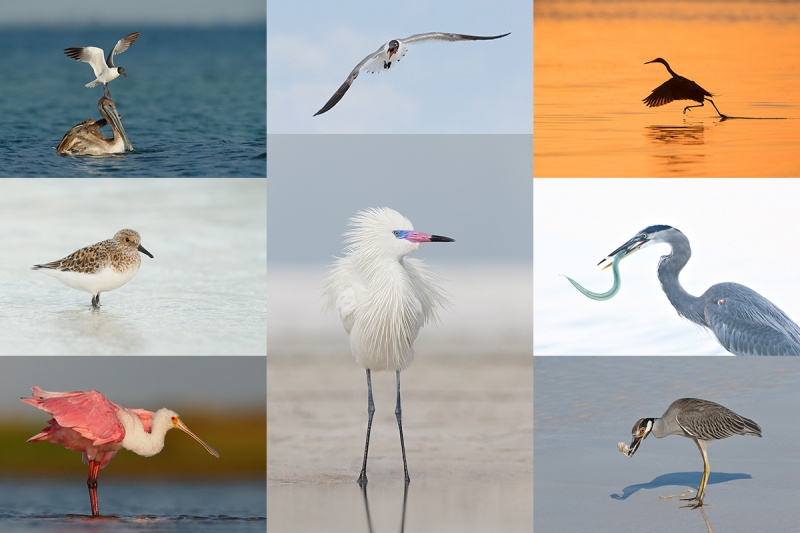
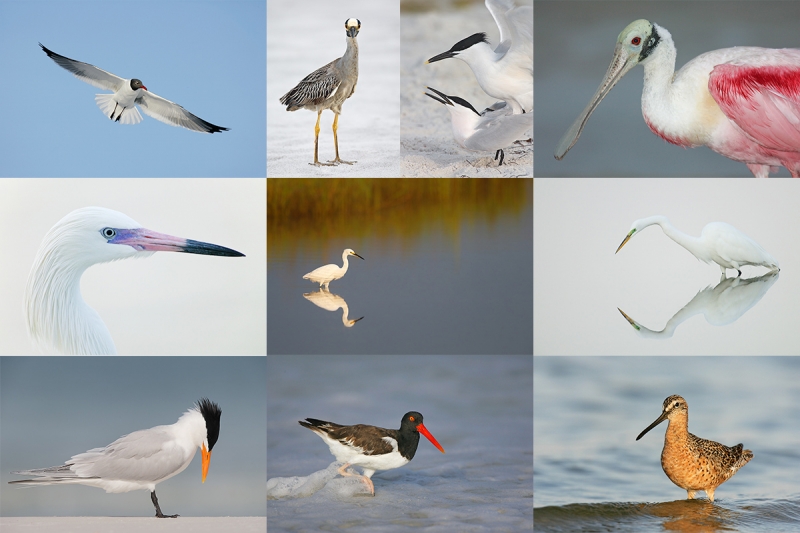
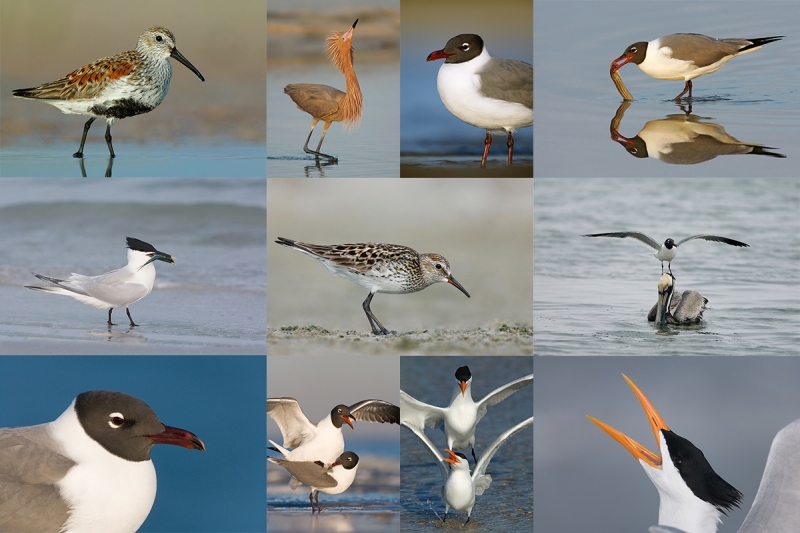
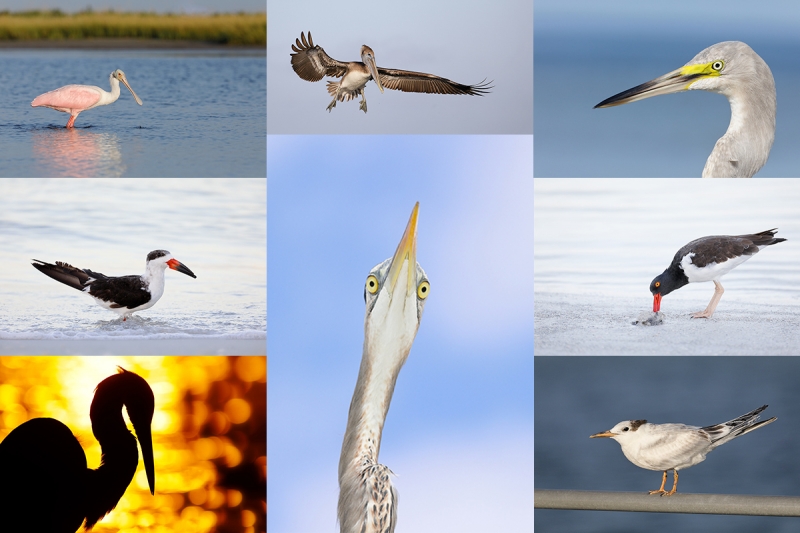
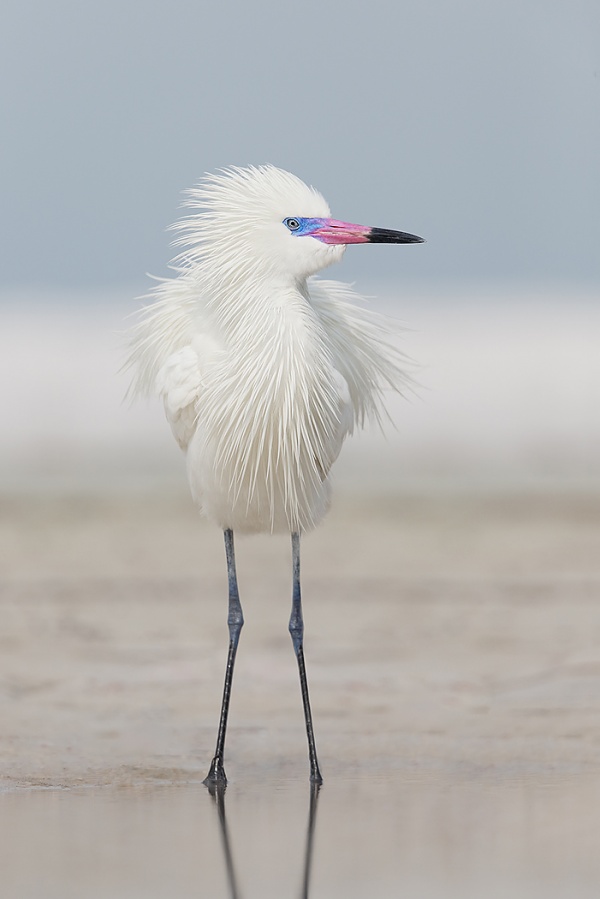
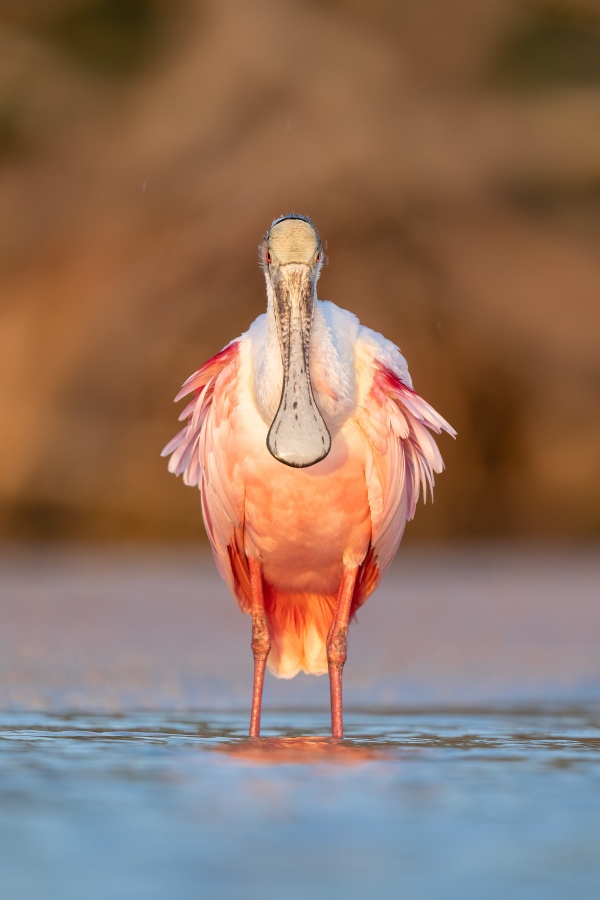
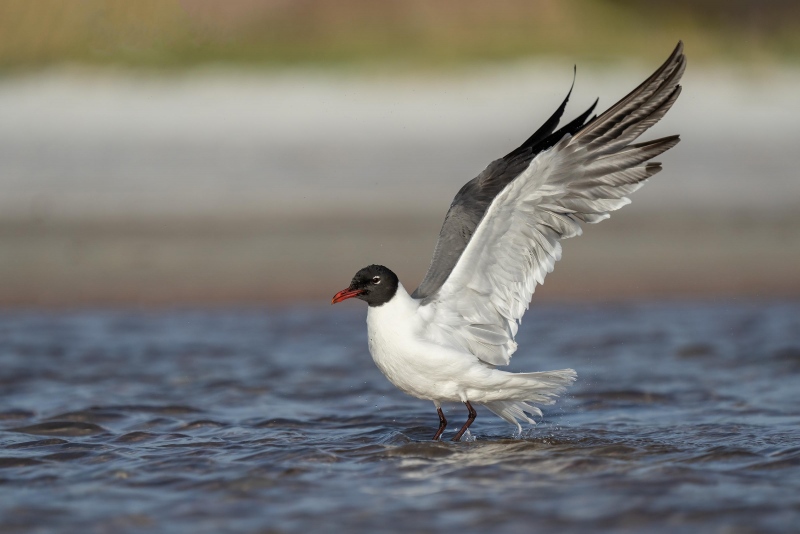
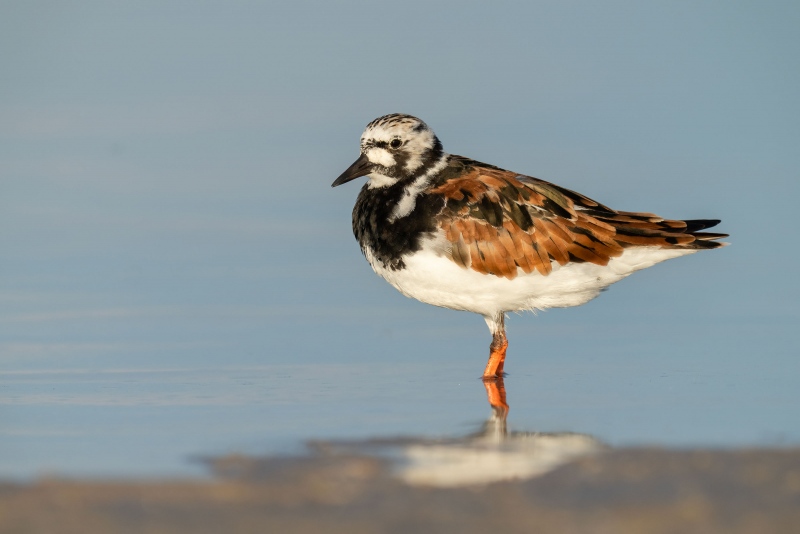













I love all the images today, Art! But number 1 is absolutely stunning, off the charts IMO!
I like all 4 images Reddish Egret and Roseate Spoonbill and Laughing Gull and Ruddy Turnstone!! All images are well made and good lighting!!
I’m most captivated by #1, the white morph is absolutely true to my heart and soul. (my eyes are happy to have ever seen this pic of such a magnificent creator) The breeding colored Ruddy would be a distant 2nd for me. Just because #1 is SO what it is.
Thanks. I was bummed out when the white morph flew away for no reason a moment after it landed!
with love, a
Images 1 & 2 for me too, purely for the stunning subject matter! Such amazing shots of two amazing birds….
#2, for the quality and balance of the light and because of the sense that the spoonbill is staring right back at me (i.e., at you and your lens).
“90 minutes hours”. I’m sure it felt like hours preparing the blog especially when you’re planning for Homer. Have a safe and productive trip. #1 is my favorite.
Thanks and fixed.
a
#1 and #2 for me for their pose and light. Very Nice!